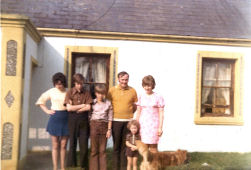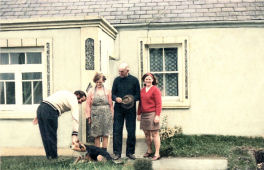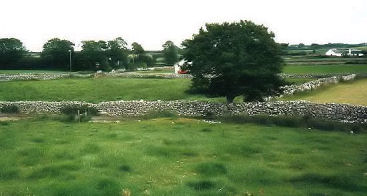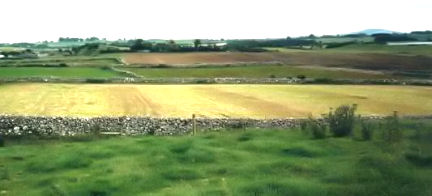Genealogy Menu
Hard Times
Despite Ireland's neutrality, the war years of 1939 to 1945 and the post-war period were times of extreme suffering and hardship, particularly for those in towns and cities, and much resourcefulness and ingenuity were required simply to eke out a basic standard of living and merely survive. There was a chronic scarcity and shortage of everything except for what the land could produce as most imports simply did not arrive because of the frequency with which ships were being sunk. A system of rationing known as 'The Emergency' was introduced. Each household received a ration book and could attend the local shop or the travelling shop once a week in order to receive its weekly ration of 2oz of sugar (57g), ½oz. of tea (14g) and three loaves of bread which were allowed per person if the family was in a position to pay for them. Often their allocated ration was not available or was insufficient forcing those who could afford it to buy on the "black market" where tea cost as much as £1 per lb. (.45kg). As each household sold eggs to the travelling shop, this provided a much needed boost to the family income as well as paying for the weekly ration. Some families were fortunate enough to receive clothing and food supplies, with items like tea and coffee, in the post from relatives in America.
During the long winter evenings, lighting was provided by paraffin oil lamps or by wax candles in the absence of paraffin oil. Central heating was a thing of the future but each room had an open fireplace where fires were lit when needed. The kitchen with its open fire was also the living room. Over the fire was fitted a steel crane that was adjustable and could be easily moved in and out over the fire. From it were suspended the cooking pots and the kettle. It was here at the table that we did our homework before the visitors arrived. For as long as I can remember, our home was the meeting place or communal centre of the nearby villages. During the long winter nights, the locals gathered there around the open fire to share stories, tell tales and spin yarns, play cards and conduct card drives as Christmas approached with turkeys and geese as prizes. Apart from the occasional radio program, local community play, parish dance, wedding or wake, our entertainment was home made. There is, however, one occasion that really stands out in my mind. Mick Caulfield who lived on the farm next to ours held all those present captive for all of two nights with a fantastic story that he began about nine o'clock one evening, retiring at midnight only to continue the story about the same time next evening for just about as long again. And as my father used to say, "That's no word of a lie".
Landowners were obliged under another measure introduced called ‘Compulsory Tillage' to till a certain proportion of their land in order to provide home produced goods to cater for the population. The harvesting of wheat, oats and barley was part of this arrangement and farmers kept so many bags of oats and wheat for their own use. In our case, these were taken as needed to the nearest mill or crusher in Shrule or elsewhere. The flour which was merely crushed wheat was made into wholemeal bread called caiscín (Kawshkeen). We all loved this type of bread with a generous spread of homemade butter.
A number of farmers, particularly those with large families, grew sugar beet which in our case was sold to the sugar factory in Tuam. Depending on the amount grown, and this was measured and checked by inspectors from the sugar factory, farmers were rewarded with so many stone of white and brown sugar. Some of this would go to needy or worthy neighbours who had helped the family in other ways with, for example, knitted socks and jumpers or other garments which were greatly appreciated as only an inferior grade of cloth was available.
As new shoes were difficult to obtain, people became excellent cobblers. I can recall the fine job my father did in repairing our old shoes with new half soles and heels. This he did by placing them on the iron shoe last and attaching the new leather with studs or tacks to original soles before shaping them to size with his special knife. More often than not though he sewed the new half-sole to the original using an awl and hemp thread treated with wax to make it waterproof. Clogs became increasingly popular and didn't I hate them. One incident in particular stands out in my mind. I was about eight at the time and we were on our way home from primary school. There was a lot of fresh snow on the ground and with every step I took in my clogs higher and higher I went, often falling over, with clump after clump of snow attaching itself with a vengeance to the steel tipped wooden soles of my clogs. It was ever so hard to remove the snow, and it happened again and again all the way home. Despite the help of my older brother, John Joe, I became ever so frustrated and upset that not even John Joe has forgotten the incident.
Of course the bicycle was the primary form of transport but like just about everything else bicycle tyres and tubes were ever so scarce. As children we spent many exciting hours constructing our own bikes from those parts occasionally discarded by others in the neighbourhood. There was nothing we couldn't do with those parts. What wouldn't fit was made to fit by patient and loving modification. Old tyres and tubes when available we in time mended with expert ease. Wooden blocks were often used when standard pedals were unavailable. To fit the blocks to the spindles, we burnt out the holes in the blocks with a narrow piece of steel heated in an open turf fire. Old saddles were mended and chains adjusted to fit, and though brakes and mudguards rarely came into the equation the final product was road tested with the anticipation and pride associated with a modern day lamborghini.
Understandably, some tasks were considerably more appealing than others. On my way to and from school, I enjoyed watching the crops grow and the meadows, which were havens for local fauna and such birds as the skylark, sway to the movements of the wind. There was something special about the smell of newly cut hay explaining perhaps why I liked helping out at harvest time. Nothing could beat working in the bog and spreading the turf, and anyone I have ever spoken to always agrees. As children we looked forward to working with Dad in the bog which was located at Dalgan just a few miles east of Shrule and each household had its own plot there. Those were really great times during the long summer days, and nothing can compare to the feel of walking barefooted on the bare bog with the squelched fresh peat rushing between your toes, or enjoying the picnic-like atmosphere while sipping the sweet bog tea prepared over the bog fire in that special bog can, or racing across the bog jumping over the new cuttings and channels to visit our neighbours, cuttings often ten feet deep filled with that brown bog water but rarely an obstacle to the vigour of youth knowing that to fall prostrate was a sort of comfort in itself. Observing the precision with which Dad used the sleán (shlaun - a special turf spade) to cut and toss the sods of turf up for us to spread and our handling those fresh and soft and slippery sods - real kids' stuff - are among those pleasant memories never to be forgotten.
Seeing nature quietly at work in the fields was something else. After they were ploughed and harrowed, and the seed broadcast by Dad and rolled into the soil, the fields in contrast to those other fields around lay flat, brown and bare. Brown and bare also were the fields of drills from end to end that were potato, sugar beet and mangel seeded. But to witness the transformation to shortly follow was such a wonderful experience. Over night the fields changed their appearance completely to a lush green, with the drills all displaying straight long green lines along the top. That was indeed a sight to behold next morning, and in no time at all the young plants ever so profuse were about 100mm high. Whenever I hear the expression 'hard labour', I can picture myself on my knees astride drill after drill of sugar beet or mangels, for hours on end, performing the thinnowing process as I moved slowly along each drill, leaving one plant standing about every 170mm and removing bare-handed all the others. Imagine those skinned and calloused knees and hands at the finish or 'láimhiragh' as Mam used to say! Seamus Heaney's poem "AT A POTATO DIGGING" though disturbingly evocative of the Great Famine does describe the task of potato picking well. The words "Fingers go dead in the cold" bring back many memories. We all dreaded the job of picking the potatoes in late autumn. It was the most back-breaking, boring and tiring job imaginable with, to echo the words of the poet, 'heads bowed and trunks bent and hands fumbling towards the cold earth' or dragging full buckets to the pit.
A few of the tasks that fell to us as children were in hindsight downright dangerous. If you have ever seen or used a hay fork with its two very long and pointed prongs, you'll appreciate the dangers in spreading and compacting hay on top of the cock or stack as it was forked up to you by often more than one person. It was rare to come away without a few pricks in your shins and thighs for your troubles.
I often wonder where Mam found the time for all the work she did. As well as often helping in the fields, she looked after the poultry, baked bread, cooked food for a large family, prepared the churn and made butter, cured bacon, carried water, did the washing, cleaned the house, prepared the 'shlits' (pieces cut from potatoes for seed) for planting, did the milking, made and mended clothes and helped with homework and more.
There were always lots of animals around and many pets among them, but there was one in particular that was everyone's favourite. Her name was Winnie and she was much more than one of our farm horses. She was a wonderfully kind and caring friend to us all. We grew up with her and from a young age could handle and work with her as well as any adult. It is difficult to imagine how such a big, sturdy animal could be so co-operative and dare I say discerning. She was happy to do whatever we asked her as long as it was safe and didn't present a threat to us as children. With bridle in hand we would call out to her and she would respond immediately. Recognising our size, she would lower her head to allow us to put the bridle on correctly. She would move alongside the stone wall to enable us to get onto her back. If she felt you weren't balanced properly or about to slip off she stopped immediately in order to allow you to re-balance. She would canter or gallop only when she sensed you were old enough to manage it. I often felt that she must have had eyes in the back of her head whenever she was harnessed to the cart. To sit high on top of a cart load of hay or sheaves was exciting, but the moment we tried to stand up Winnie stopped immediately and refused to move till we were seated again. The simple way to get into the cart was to step on the spoke of the cart wheel and hop aboard. There was no way you could get her to move if you were anywhere near the wheels or in front of the cart, and she would look from side to side to see where you were. I can recall so many situations when she intervened in order to ensure our safety. One in particular stands out in my mind. I was fetching a canful of fresh water from Caulfield's well and had just crossed over the style into our property. As I crossed the field where the sheep were grazing, I noticed Winnie who was in the same field galloping towards me. Little did I realise at the time that a young ram had positioned himself to charge at full pelt. Suddenly Winnie had positioned herself between the ram and me challenging every one of his moves while at the same time half turning her head towards me and neighing with such urgency as if saying, "Get to hell out of here quickly". And of course I gratefully obeyed.
In the weeks leading up to Easter, we would leave our warm beds at seven in the morning and cross the fields to check on the number of new-born lambs. The fact that it was often freezing cold escaped our attention as our minds were preoccupied. Occasionally, when we came across a sheep having difficulty lambing, we would give her whatever help she needed in order to ensure the safe birth of her lamb. Sometimes that meant using techniques that we had acquired along the way, and sometimes it meant summoning our father to the rescue when the going got too tough. To be given an egg for breakfast was a rarity and came as a reward for having achieved something. Arising early in the cold of the spring morning to locate the new-born lambs was deemed such an achievement. During the coldest winters we were clad in shorts, shirt, and jumper which was usually home made. Boys had to wait until they had finished primary school to qualify for the wearing of trousers. It wasn't so much a case of having or not having. It was instead a case of making do with what you had. No one that you knew had very much more or less than yourself. Being a child or teenager didn't set you apart from your parents and other adults. Generally speaking, you were involved in their conversations and adults accorded you the same respect as they showed one another.
The local smithy was always in great demand, and of course we all could recite "The Village Blacksmith" from an early age. There were a few blacksmiths in our area but the one I saw as our blacksmith was Jack Ford of Kill (Cille) whose forge was there at the junction of the Shrule and Cahermaculick roads. His trade was a busy one and was in great demand until the early 1950's when the tractor gradually took over. It was common to see a number of horses in line to be shod just about every day but particularly during spring-time. I can't recall ever going past there without stopping to watch him ply his trade. Like so many others, I found the whole culture of the forge fascinating from the rhythmic ring of the anvil heard from afar and the lingering cloud of smoke with its rather intoxicating smells to the roar of the bellows and the sight of white heat as the irons turned white from the great heat of the forge fire.
The making and fitting of steel tyres on large wooden wheels for carts, traps and side cars was a very difficult job that required great skill and patience. To observe the welding process alone of knotting the ends and heating them to the point of melting before forcefully hammering them to create the perfect weld was quite an education. Among other things, the farmer also relied on the blacksmith to supply and repair steel shoes for both the standard and drilling ploughs, and leaves and springs for the harrows, as well as cart axles and gates, both plain and fancy.
That was the Ireland I knew and that was the Ireland I left in 1955. As I have said earlier, Ireland has seen so much change in recent years as a member of the European Union, and most of it for the better, that it's difficult for the younger generation to perceive of an Ireland that was so very different from their own. Despite the deep scars still in the Irish psyche, gone forever are the many yokes of her past history, those yokes of servitude that fastened her to centuries of barbaric treatment and until quite recently to economic misery and stagnation. Ireland today 2007 is a very modern and vibrant nation with an unique culture and a very successful economy, and with that same indomitable spirit and sense of fun and optimism that have been the hallmarks of her dignity down the centuries and hopefully into the future.
My parents have passed on but I am grateful that they lived long enough to see the new Ireland. The land that became my grandparents' land nearly a hundred years ago is still in the family. Today it is worked by my brother Noel and his family.
 Nonnie, Pat, Martin John Joe, Bridie & John 1974 |
 Cahermaculick Family Home 1960's |
 Paula Hogan ex Sydney with Mum, Dad, Noel & Tim 1976 |
|
|
|
 |
|
 |
|
 |
The Coleman Home in Cahermaculick as it was until 1974 when a new one was built
in the field across the road
 Clan Coleman
Clan Coleman
